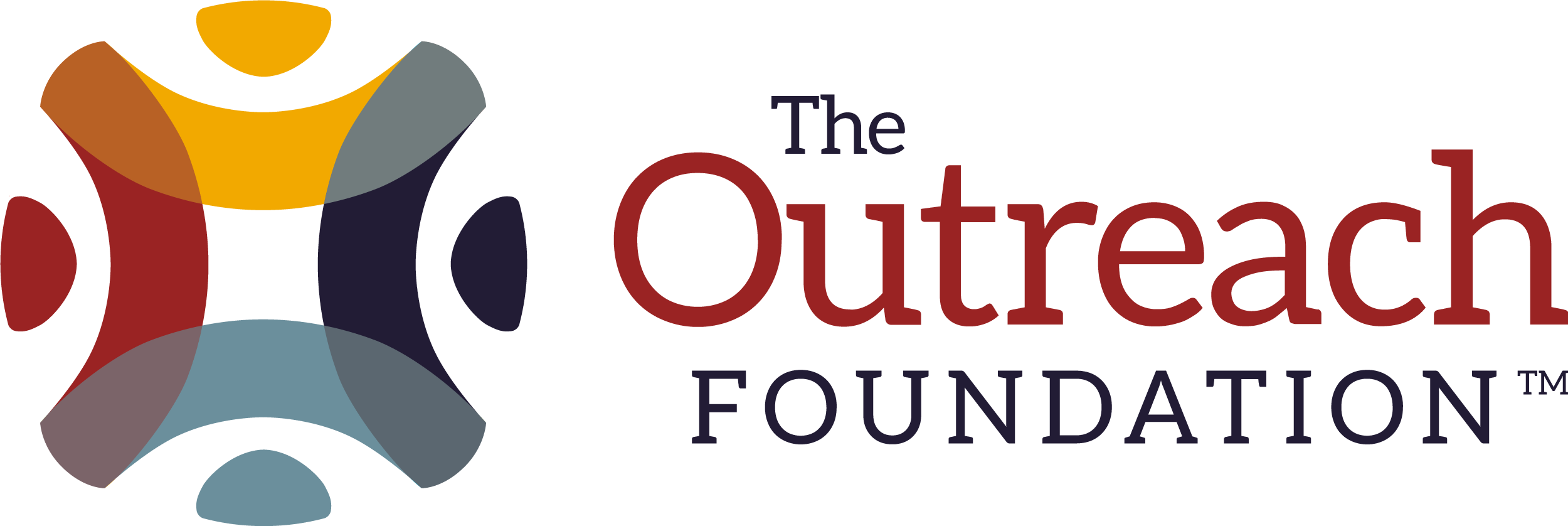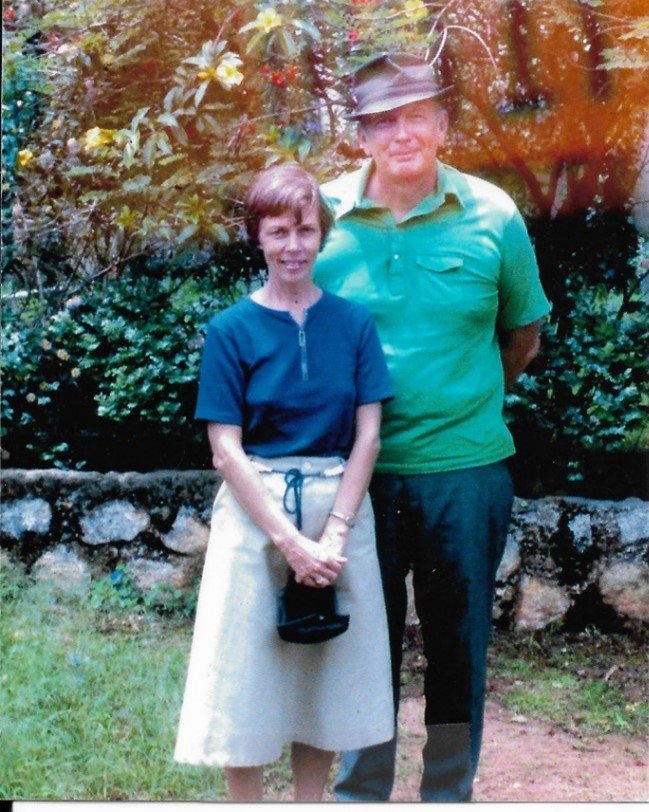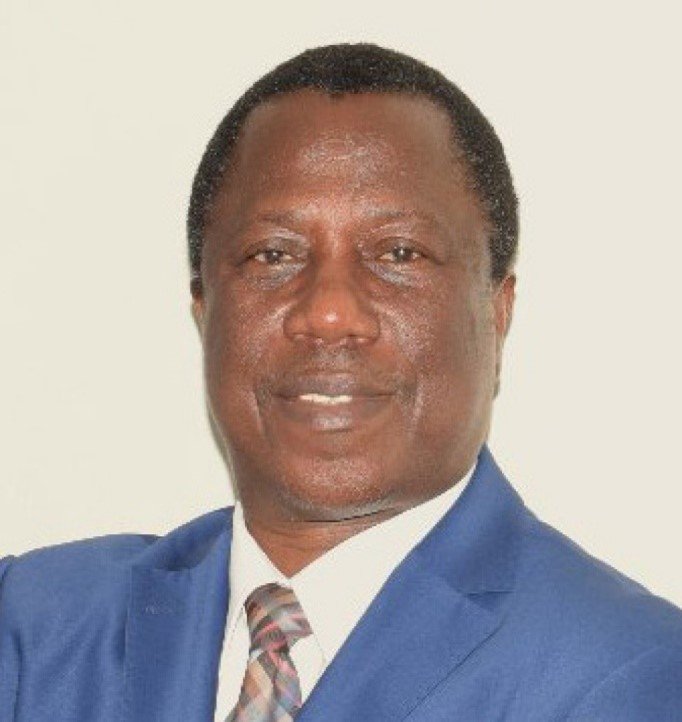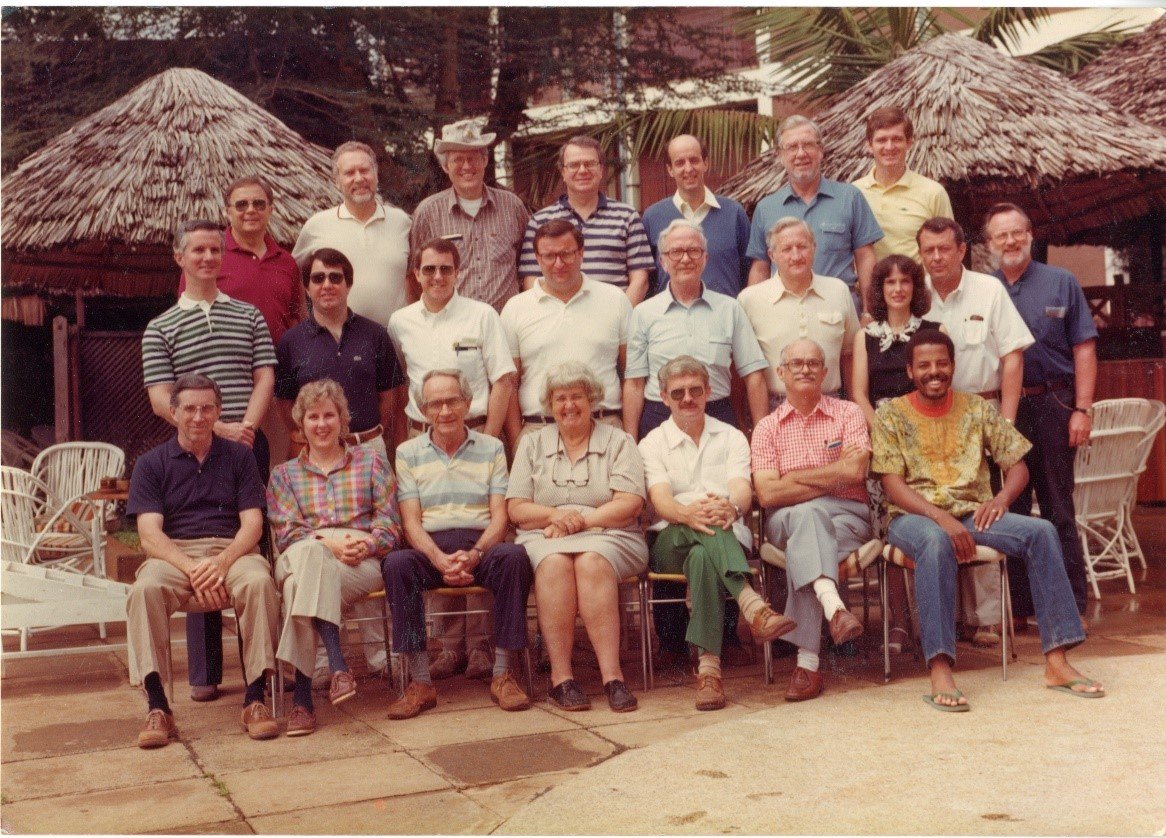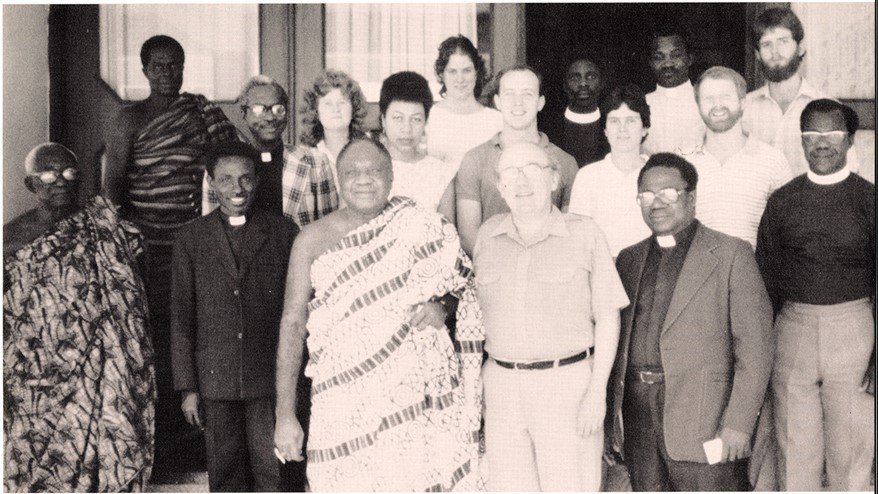The Outreach Foundation in Ghana: 1984-2020
Sankofa: “Go back to fetch it.”
That is, we need to go back and learn our history so that we may plant seeds for the future generations that come after us.
The Outreach Foundation in Ghana: 1984-2020
by Jefferson Ritchie
The beginning of each blog in this history will include an “Adinkra symbol” or some other visual representation of the cultures of Ghana. Adinkra symbols come from the Akan culture of central Ghana. They communicate deeply held beliefs about God and the collective wisdom of the Akan peoples that have been passed down from one generation to another.
Chapter 1
American Presbyterian Encounters with the Presbyterians of Ghana, 1957-1983
Gye Nyame: “Except God.”
It refers to the omnipotence and supremacy of God in all things. It is the most widely known of the Adinkra symbols.
This volume is the third in a series of histories of The Outreach Foundation in countries for which I was the primary liaison of The Outreach Foundation. The story of The Outreach Foundation in Ghana predates my arrival at Outreach by more than a decade, and the story of the Church in Ghana precedes The Outreach Foundation’s existence by over 150 years. Some of the themes that I will be emphasizing in this history are the collaborative nature of the mission work in the early years of The Outreach Foundation’s involvement in Ghana, the role of personal relationships that we developed with key leaders that have driven the work over the years, and above all, the sense that Christianity in Africa, of which Ghana is but one example, is in some sense “representative Christianity.” [1]
This chapter sets the stage for the arrival of The Outreach Foundation in Ghana in the mid-1980s. A brief summary of the origin of the Presbyterian churches in Ghana will be followed by an account of how American Presbyterians became engaged in Ghana.
Emergence of the Presbyterian Churches in Ghana: The Presbyterian communions in Ghana arose out of mission efforts in the first half of the 19th century by the Swiss Basel Mission Society, the German Bremen Mission Society, and Moravian Christians from Jamaica. The work of the Basel Mission and their Jamaican co-workers resulted in the Presbyterian Church of Ghana (PCG), the majority of whose members spoke Twi or Ga, the dominant languages of central and southern Ghana. The Bremen Mission worked among the Ewe-speaking people in what is now eastern Ghana and western Togo. The Evangelical Presbyterian Church of Ghana (EPC,G) [2] and the Evangelical Presbyterian Church of Togo are the fruits of their labors.
The two Ghanaian Presbyterian denominations were independent, self-governing churches by the time of their country’s independence in 1957. They were also early participants in the worldwide ecumenical movement that began in the 20th century. Nationally, both the PCG and the EPC,G belonged to the Christian Council of Ghana. Internationally, both churches participated in the International Missionary Council (IMC) and hosted its 1957-58 Assembly in Ghana.
American Presbyterians Encounter Ghana: At the International Missionary Council Assembly, American Presbyterians were present and were quite impressed with the Presbyterian communions in Ghana. The Assembly itself was a significant meeting for the World Christian Movement. Mission terminology used in earlier Protestant mission circles such as “sending and receiving countries” and “older and younger churches” was discarded, and a new IMC theme was chosen: “One Church Sent with the Whole Gospel to the Whole World in Obedience to Christ.”
Missionaries, Church Partners, and Seminarians in the Early Days of American and Ghanaian Presbyterian Encounters
The representatives of the two major American Presbyterians denominations saw in Ghana a place where the new mission theme could be put into practice. Up to this point, the United Presbyterian Church in the USA (UPCUSA) and the Presbyterian Church in the United States (PCUS) had engaged in pioneer mission in Africa, planting the first Presbyterian churches in countries such as Congo, Cameroon, and Ethiopia. In Ghana, the work of establishing the church had been accomplished. Ghana’s two Presbyterian communions and the Christian Council of Ghana were potential partners with which the UPCUSA and the PCUS could join hands as “one church sent with the whole gospel to the whole world in obedience to Christ.”
Initially, the United Presbyterian Church in the United States of America (UPCUSA) sent short-term missionaries to Ghana in the early 1960s to work on specific projects of the Church in Ghana. The Presbyterian Church in the United States (PCUS) appointed a couple for regular (long-term) missionary service in 1968, the Rev. Harry Petersen and Mrs. Martha Jane Petersen. Having previously served in Taiwan, the Petersens were invited to help the Christian Council of Ghana establish the first full-time Protestant Chaplaincy on the campus of the University College of Cape Coast.
After three years in this ministry, the Petersens moved to Accra where they served seven years. In Accra, Harry Petersen pastored an ecumenical church of Methodists, Anglicans, and Presbyterians. He also taught New Testament at Trinity Theological College, an ecumenical seminary serving both Presbyterian denominations and the Methodist and Anglican communions in Ghana. Martha Jane Petersen was a “Communications Missionary.” In that role, she contributed articles to Presbyterian Survey, the official PCUS magazine, and to other publications of the denomination. She was also responsible for the Petersen’s regular mission correspondence letters which informed American Presbyterians about Ghana and the Church in Ghana. In addition to their official tasks, the Petersens connected American Presbyterians with the Church in Ghana in a variety of ways. For example, they opened the way for a professor at Columbia Theological Seminary to spend a sabbatical in Ghana.
Following their ministry in Ghana, the Petersens were reassigned to Nigeria where they served three years. They then returned to the United States where Harry, or “Pete,” as he was widely known, became the Director of Villa International in Atlanta, Georgia. Martha Jane continued to be a mission advocate for the Church in Africa through her publication, “God’s Fire,” a resource for PCUSA churches during a season of mission emphasis on Africa in Winter, 1984. [3]
Other Presbyterian “Paths” to Ghana--PATH of the Presbytery of Atlanta: In the early 1970s, the Presbyterian Church in the United States (PCUS) established an office dealing with issues of hunger. Over time, the presbyteries of the denomination established their own hunger programs. The Presbytery of Atlanta’s hunger office was PATH, short for “Presbyterian Answer to Hunger.” Local churches were encouraged to have their members collect two cents per person for each meal. The penny offerings collected in each home were brought to church on a Sunday which that congregation had designated to receive their “2 cents a meal offering.” The PATH Committee of Atlanta Presbytery, later Presbytery of Greater Atlanta, used the money raised to support projects, both locally and abroad.
How did the Atlanta Presbytery’s Hunger Program get connected with Ghana? It was partly due to geography. Atlanta was the site of the General Assembly offices of the Presbyterian Church in the United States. Sometime in the 1970s Atlanta Presbyterians involved with PATH attended a conference at the Presbyterian headquarters on the impact of the Volta Dam in Ghana. This dam had been constructed in the 1960s with significant investment of the United States government. While it enabled the production of large amounts of electricity for Ghana, the resulting lake that was formed by the dam displaced thousands of people who then had to find new ways of earning a living. Many of these persons were Presbyterians.
The PATH committees of Atlanta Presbytery and neighboring Cherokee Presbytery decided that they would do something to help these displaced people in their transition from being farmers to becoming fishermen. The PCUS staff for Africa connected them with the Christian Council of Ghana, and a partnership in mission began. PATH provided nets for those engaged in fishing and sewing machines for those who had begun cottage industries of sewing.
A group from PATH visited Ghana in 1983 to see the impact of their partnership. One of the participants on that trip, the Rev. Joe Sandifer, related in an interview how the trip inspired him, both in terms of the impact of the mission support provided by PATH to the displaced persons and in terms of the partners whom he met. He mentioned that he still keeps in touch with some of the Ghanaian friends he met on that trip, such as Dr. Bright Mawudor, formerly the Finance Officer of the Evangelical Presbyterian Church, Ghana, and currently the Deputy General Secretary for Finance and Administration of the All Africa Conference of Churches.
These early presbytery international partnerships were the first of several presbytery partnerships American Presbyterians would form with the two Presbyterian communions in Ghana. Presbytery partnerships with the global church were to become a significant component of the Presbyterian world mission over the next forty years.
American Presbyterian Seminary Connections in Ghana—Union Presbyterian Seminary: In the early 1980s, two events provided yet another opportunity for American Presbyterians to connect with the Church in Ghana. First of all, the Women of the Church of the Southern Presbyterian Church (PCUS) raised funds for the internationalization of theological education through one of their annual Birthday Offerings. Secondly, the General Assembly of the PCUS in 1982 voted to highlight Presbyterian mission in Africa during its annual “Witness Season” in the winter of 1984. The General Assembly’s Division of International Mission looked for some people who could go to Africa in 1983 and return as mission interpreters to inspire the church with what God was doing in Africa.
One of the people they chose was a young pastor serving in Rome, Georgia, the Rev. Mary Jane Winter. For three weeks in the spring of 1983, she and the other team members visited Ghana, Congo, and Kenya. [4] It was Ghana that caught her mind and heart. “It was a life-changing experience,” Pastor Winter said in an interview in early 2021. “There were no [PCUS] missionaries! Africans led the church!”
After her return, Mary Jane Winter received a call to the staff of Union Theological Seminary in Richmond, Virginia (now Union Presbyterian Seminary). She was responsible for the seminary’s constituency relations, and one of those “constituents” was the Women of the Church. As a result, Winter joined the seminary’s committee that was dealing with how to use their portion of the Women’s Birthday Offering in support of the internationalization of theological education.
At the time, most of the seminaries were using their Birthday Offering funds to send faculty to seminaries in other countries. Fresh from her experience in Ghana, Mary Jane said, “Let us use these funds for students to experience the global church.” She wrote a project that would provide opportunities for Union students to go to Trinity College in Ghana and provide scholarships for students from the Presbyterian Church of Ghana and the Evangelical Presbyterian Church of Ghana to study at Union.
The seminary’s committee concurred with the proposal, but the churches in Ghana requested that, instead of sending their seminary students to the United States, pastors from each of the Ghanaian Presbyterian denominations be sent as an opportunity for continuing education. The seminary agreed, and beginning in 1986, the first group of Union students, along with the Dean of the Faculty, spent a semester in Ghana. That fall, a pastor from the PCG and one from the EPC came to Union.
When the funding from the Women’s Birthday Offering ran out, the seminary raised the funds to continue the exchanges. As the years went on, Union added other international exchanges to their program, and the Ghana program became an every-other-year event.
What was the impact of the internationalization of theological education on Union and on the Church in Ghana? Pastor Winter shared the following points:
at one point, 10% of the pastors in the EPC,G had studied at Union;
the “bright, gifted, and strong” leaders from the Ghanaian Church who attended Union inspired the students, faculty, and administration of the American seminary through the relationships that developed among Ghanaian and American Presbyterians;
an alumnus of the first group of Union students to study in Ghana, the Rev. Dr. Ken McFayden, is now Dean of the Seminary and a strong advocate for global theological education.
Decentralized Mission: One of the most interesting facets of this early history of the US Presbyterian Church and mission connections in Ghana was the decentralized approach of the Presbyterian Church in the United States (PCUS) took regarding mission in Ghana. The General Assembly’s work in Ghana, the initiative of Union Presbyterian Seminary, and the work of PATH arose out of the common mission theology that had been expressed at the Ghana Assembly of the International Missionary Council. Yet each initiative had a life of its own, equally valued by the Ghanaian churches. Mrs. Mary Bartholomew, the second director of the PATH ministry of Greater Atlanta Presbytery (1985-1989), told me in an interview that the partners in Ghana considered groups like PATH on the same level as the denominational mission leadership—PATH was their mission partner and friend. In the spirit of the mission slogan of the 1957 International Missionary Council, Presbyterians in the United States at all levels were being mobilized for mission in Ghana.
Meanwhile, another initiative of American Presbyterians in Ghana was about to begin. This initiative was an intentional collaboration among the Division of International Mission of the Presbyterian Church USA, a Presbyterian elder from West Virginia, a couple who had served as Presbyterian missionaries to Zaire in the 1960s and 1970s, and a group of Presbyterian pastors and elders who began a new mission organization, The Outreach Foundation. “Gye Nyame,” the Sovereign God, was calling American Presbyterians to mission in Ghana.
———
[1] See Kwame Bediako, “A New Era in Christian History—Arican Christianity as Representative Christianity,” Journal of African Christian Thought (Vol. 9, No. 1, June 2006), p. 3
[2] The Evangelical Presbyterian Church of Ghana experienced a split during the period that this history covers. The initials used to describe the Evangelical Presbyterian Church with which The Outreach Foundation had its partnership included a comma between the “C” and the “G”—(EPC,G).
[3] Martha Jane Petersen, God’s Fire: A Personal Journey (Atlanta: Office of Interpretation, Presbyterian Church (USA), 1984).
[4]The trip coincided with the PATH visit to Ghana, and the two delegations traveled together.
